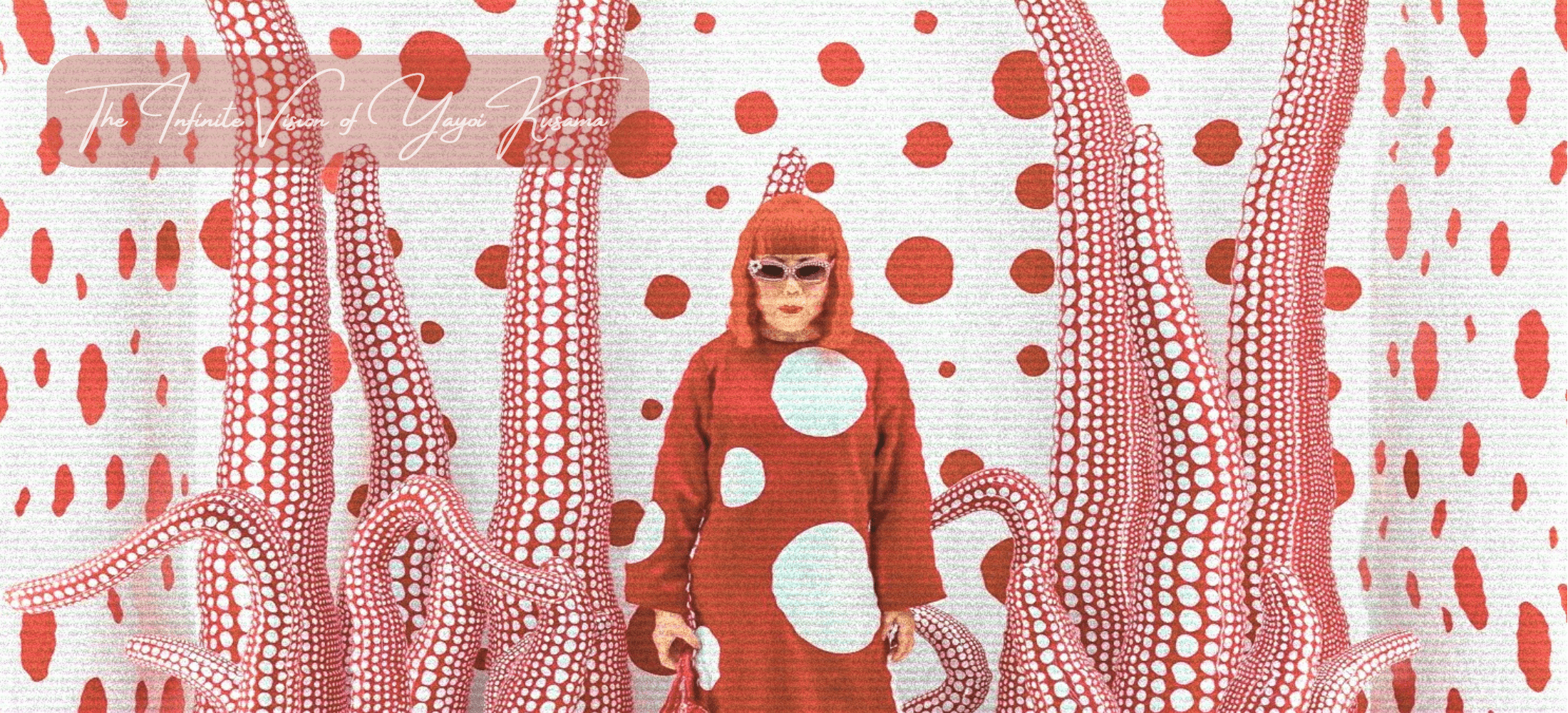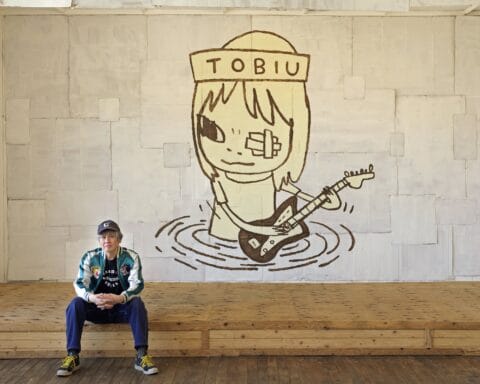The world of contemporary art is a labyrinth of shifting forms, vibrant hues, and diverse expressions, each piece an echo of the human condition striving to capture the ineffable. Amidst this cacophony of creative voices, Yayoi Kusama stands as a singular figure—her work a hypnotic symphony of polka dots, infinite nets, and mirrored rooms that invite viewers into the boundless expanses of her mind. Her art is not merely a visual experience but a profound exploration of the psyche, the cosmos, and the fine line between the two.
Kusama’s journey from a troubled childhood in Matsumoto, Japan, to the pinnacle of the global art scene is a story of resilience, defiance, and an unyielding commitment to her vision. Her works, often pulsating with the repetitive patterns and obsessive details, are more than aesthetic statements; they are the tangible manifestations of a mind wrestling with the concepts of infinity, self-obliteration, and existential dread. Each piece serves as a portal into her consciousness, offering viewers a glimpse of the universe as seen through the eyes of an artist who has spent her life on the precipice between reality and illusion.
This essay embarks on an intellectual voyage through the life and work of Yayoi Kusama, seeking to unravel the intricate tapestry of her artistic journey. It will explore the symbiotic relationship between her psychological struggles and her creative output, examining how her personal battles have been transmuted into a universal language of art that transcends cultural and temporal boundaries. By delving into the themes of infinity, the dissolution of the self, and cosmic consciousness, this essay aims to articulate the philosophical underpinnings of Kusama’s art, positioning her as a pivotal figure in the contemporary art world.
Yayoi Kusama’s oeuvre is a testament to the power of art as a tool for both personal catharsis and profound philosophical inquiry. Her work challenges us to confront the vastness of the universe, the fragility of our own existence, and the permeable boundaries between self and other. In doing so, Kusama has created not just art but an entire cosmos—a boundless, pulsating expanse where the infinite and the intimate coexist in a delicate dance of dots and nets.

I. Early Life and Formative Influences
1. Background and Childhood
Yayoi Kusama was born on March 22, 1929, in Matsumoto, a rural city nestled within the mountainous Nagano Prefecture of Japan. Her family, affluent yet deeply fractured, provided little comfort or stability during her formative years. Kusama’s mother, a domineering figure, was often emotionally distant and, at times, abusive, while her father was largely absent, indulging in extramarital affairs that left a profound mark on young Kusama’s psyche. These early familial tensions sowed the seeds of what would become lifelong struggles with mental health, ultimately shaping the trajectory of her artistic career.
Kusama’s early life was marred by more than just familial discord; she began experiencing vivid hallucinations at a young age, visions that would haunt her and drive her to create. These hallucinations were not merely fleeting images but intense, immersive experiences in which the world around her dissolved into a sea of patterns and colors, often dominated by the polka dots that would later become a signature element of her art. For Kusama, these visions were both terrifying and mesmerizing, a double-edged sword that would both torment and inspire her throughout her life.
Her childhood was also marked by an acute sense of isolation. Kusama found herself alienated not only from her family but from the world at large. Her artistic inclinations, which she began to manifest as early as the age of ten, were met with little encouragement. In fact, her mother actively discouraged her from pursuing art, often confiscating her materials and criticizing her efforts. Yet, it was within these moments of solitude that Kusama began to develop the unique visual language that would define her work—an attempt to externalize the internal chaos that she could neither escape nor fully comprehend.
2. The Genesis of Artistic Obsession
The origins of Kusama’s artistic obsession can be traced back to the stark contrast between her internal world and the external reality she found so difficult to navigate. As a child, Kusama sought refuge in drawing and painting, using art as a means of coping with her tumultuous inner life. The act of creation became an obsessive ritual, a way to impose order on the disarray of her thoughts and emotions. This compulsion to create, to manifest her inner visions onto canvas, would remain a constant throughout her life, intensifying as she grew older.
Kusama’s early works, though rudimentary, already exhibited signs of the motifs that would later dominate her oeuvre. She began experimenting with repetitive patterns, particularly polka dots, which she used as a way to cover and obliterate the world around her. This act of obliteration was not just a visual exercise but a deeply psychological one, an attempt to neutralize the overwhelming stimuli that threatened to engulf her. The polka dots became both a shield and a weapon, a means of distancing herself from the pain of existence while simultaneously confronting it head-on.
The genesis of Kusama’s obsession with infinity and self-obliteration can also be linked to the cultural and historical context in which she was raised. Growing up in post-war Japan, Kusama witnessed the devastation and existential uncertainty that permeated the society around her. The trauma of the atomic bombings and the subsequent cultural upheaval left an indelible mark on the collective consciousness of the Japanese people, and Kusama was no exception. This historical backdrop, combined with her personal struggles, fueled her desire to explore themes of destruction, rebirth, and the infinite, both in her art and in her life.
3. Cultural and Historical Context
Yayoi Kusama’s early life unfolded during a period of profound transformation in Japan, a nation grappling with the aftermath of World War II and the rapid changes that followed. The post-war era in Japan was characterized by a complex interplay of traditional values and the influx of Western influences, as the country sought to rebuild and redefine itself. This cultural milieu had a significant impact on Kusama, both in terms of the challenges it posed and the opportunities it presented.
As a child, Kusama was exposed to the rigid social norms and expectations of pre-war Japan, which emphasized conformity and obedience, particularly for women. However, the war and its aftermath brought about a gradual loosening of these strictures, creating a space for new ideas and artistic expressions to emerge. For Kusama, this period of transition offered a glimpse of the possibilities that lay beyond the confines of her upbringing, igniting a desire to break free from the constraints of her environment and explore new avenues of artistic expression.
The trauma of the war and its lingering effects on the Japanese psyche also played a crucial role in shaping Kusama’s artistic vision. The devastation wrought by the atomic bombings of Hiroshima and Nagasaki left a deep scar on the national consciousness, leading to widespread existential angst and a questioning of the meaning of life. Kusama, who had already been grappling with her own inner demons, found herself drawn to these themes of destruction, loss, and the fragility of existence. Her art became a way to process and express the collective trauma of her generation, as well as her own personal struggles.
In this context, Kusama’s decision to pursue art as a means of self-expression and survival was both a bold and necessary act. She recognized that in order to fully realize her vision, she would need to leave behind the confines of her traditional upbringing and embrace the new, often turbulent world that was emerging in the wake of the war. This realization would eventually lead her to seek out new horizons, both artistically and geographically, setting the stage for the next phase of her life and career.
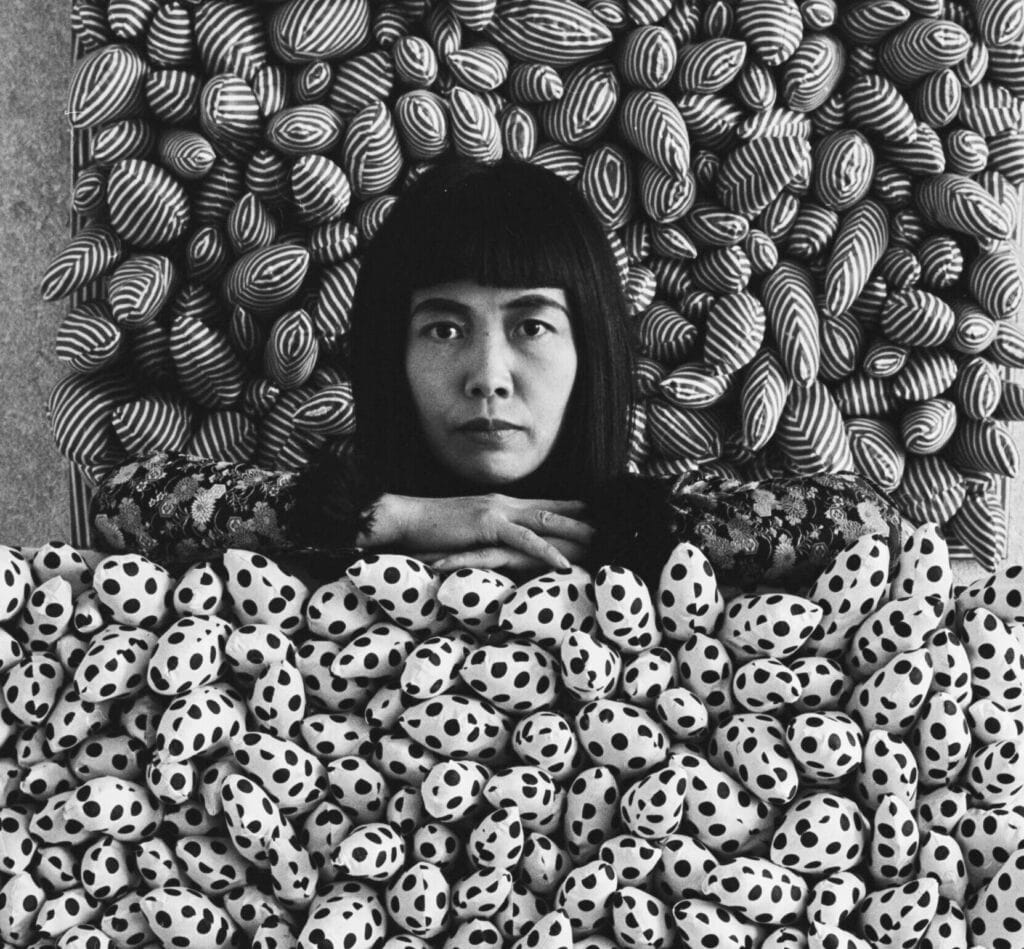
II. The Migration to the West and Artistic Awakening
1. Move to New York City
In 1957, Yayoi Kusama made a bold decision that would irrevocably change the course of her life and career: she left Japan for the United States, settling in New York City. This move was not merely a geographical relocation but an existential leap into the unknown, driven by a deep-seated desire to escape the stifling confines of her homeland and immerse herself in the epicenter of the global art scene. For Kusama, New York represented a realm of boundless possibilities, where the avant-garde was not only accepted but celebrated—a stark contrast to the conservative art world of Japan.
Upon arriving in New York, Kusama was confronted with the sheer scale and intensity of the city. The urban landscape, with its towering skyscrapers and relentless energy, mirrored the vastness and complexity of her own inner world. This new environment proved to be both overwhelming and exhilarating, fueling her creative impulses and pushing her to explore new artistic territories. She was particularly drawn to the burgeoning minimalist and pop art movements, whose emphasis on repetition, industrial materials, and the blurring of boundaries between high and low art resonated with her own sensibilities.
Kusama’s early years in New York were marked by immense personal and professional challenges. As a young Japanese woman in a predominantly male-dominated art world, she faced significant obstacles in gaining recognition and establishing herself as a serious artist. Yet, her determination and resilience were unwavering. Kusama began producing large-scale works that defied categorization, blending elements of painting, sculpture, installation, and performance. These works were not merely artistic experiments but bold declarations of her unique vision—a vision that sought to transcend the limitations of traditional art forms and engage with the infinite.
2. Integration into the Avant-Garde Scene
Kusama’s arrival in New York coincided with a period of intense artistic innovation and experimentation. The city was a hotbed of creativity, attracting artists, writers, and thinkers from around the world who were eager to push the boundaries of art and culture. Kusama quickly immersed herself in this vibrant milieu, forging connections with some of the most influential figures of the time, including Andy Warhol, Claes Oldenburg, and Donald Judd. These relationships, while complex and at times fraught with tension, played a crucial role in her development as an artist.
Her integration into the avant-garde scene was not without its challenges. Kusama often found herself marginalized due to her gender and ethnicity, struggling to gain the same level of recognition and respect as her male counterparts. However, she refused to be deterred. Instead, she harnessed her outsider status as a source of strength, using it to fuel her creative output and to challenge the prevailing norms of the art world.
During this period, Kusama began to experiment with new materials and techniques, creating works that blurred the line between painting and sculpture. Her “Accumulation” series, which featured everyday objects such as chairs and sofas covered in phallic protrusions, was a direct challenge to the male-dominated art world and its emphasis on the heroic, abstract gestures of the likes of Jackson Pollock and Willem de Kooning. These works were not only visually arresting but deeply subversive, questioning the very foundations of artistic production and the role of the artist in society.
Kusama’s relationship with Warhol is particularly noteworthy. The two artists shared a fascination with repetition and the obliteration of the self within their work. While Warhol’s repetitive use of iconic imagery in his silkscreens can be seen as a commentary on mass production and consumer culture, Kusama’s approach was more introspective, reflecting her own psychological struggles and her desire to transcend the boundaries of the self. Despite their different motivations, the dialogue between Kusama and Warhol contributed to the development of her unique artistic language, which would come to define her work in the years to come.
3. Innovation and Identity
As Kusama’s work evolved, so too did her identity as an artist. Her time in New York was marked by a constant tension between her Japanese heritage and her desire to forge a new identity within the Western art world. This tension was both a source of conflict and a catalyst for innovation, pushing her to explore new ways of expressing her experiences and ideas.
One of the most significant aspects of Kusama’s work during this period was her exploration of the relationship between the self and the other, a theme that would become increasingly central to her practice. This exploration was informed by her experiences as an outsider in both Japan and the United States, as well as her struggles with mental illness. Kusama’s art became a means of negotiating her identity, both as an individual and as an artist, within a world that often seemed hostile and indifferent.
Her innovative use of materials and techniques also reflected this ongoing negotiation. Kusama began to incorporate elements of traditional Japanese art and culture into her work, such as the use of natural materials and the emphasis on repetition and simplicity. At the same time, she continued to engage with the latest developments in Western art, experimenting with new forms and concepts that challenged the boundaries of what art could be.
Kusama’s work during this period was also characterized by a growing interest in performance and installation art, which allowed her to create immersive environments that engaged the viewer on multiple levels. These works were not just about visual aesthetics but about creating a space where the boundaries between the self and the world could dissolve, allowing for a more profound connection with the infinite.
This phase of Kusama’s career was a time of intense creativity and experimentation, as she sought to reconcile the different aspects of her identity and to create a new artistic language that could express the complexities of her experiences. It was a period of both personal and artistic awakening, setting the stage for the next phase of her journey and the development of her most iconic works.
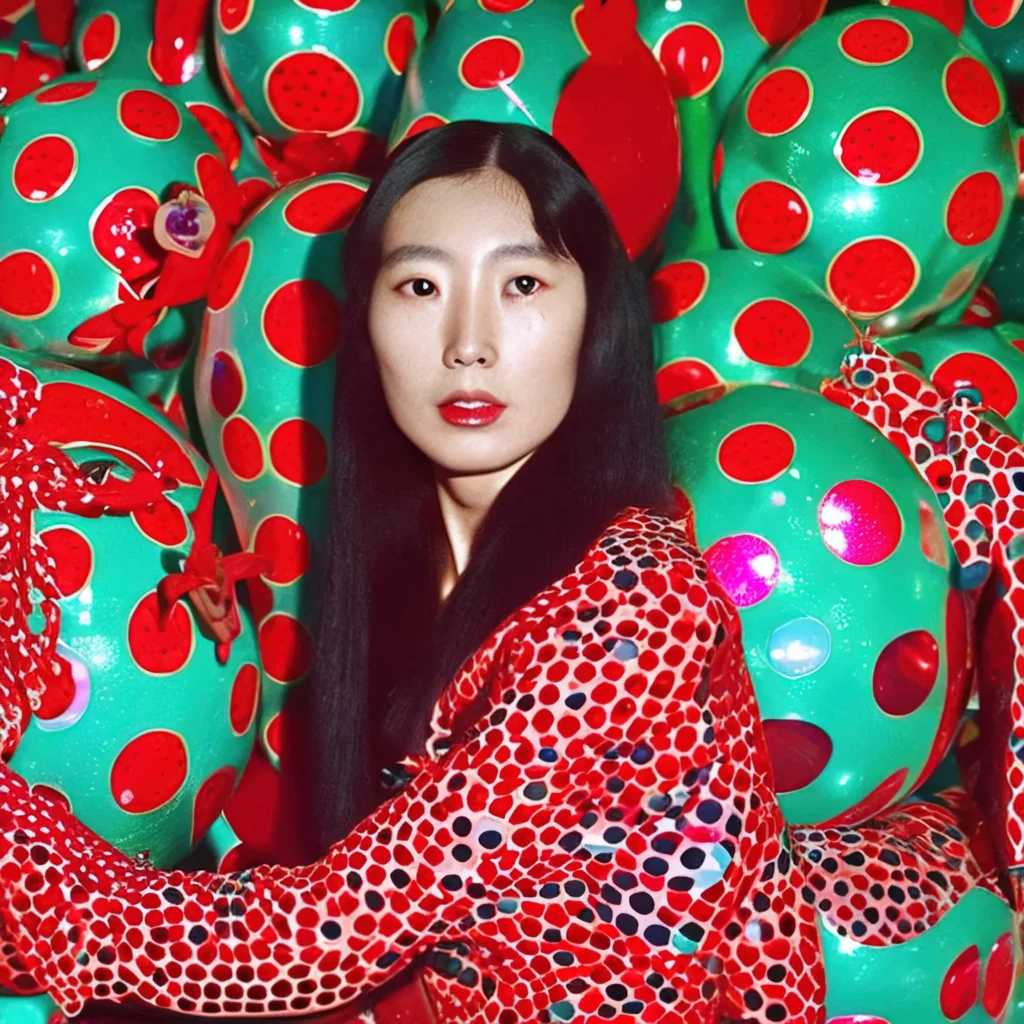
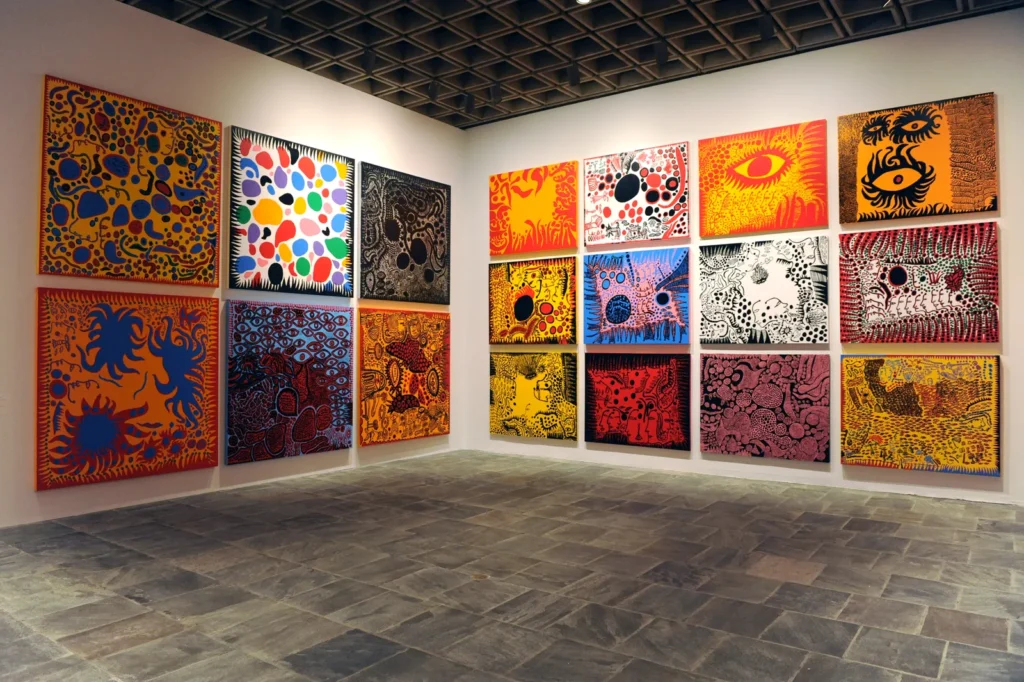
III. Polka Dots and the Infinity Net Series: Symbols of Cosmic Reflection
1. Polka Dots as a Symbol
Yayoi Kusama’s use of polka dots is arguably one of the most recognizable and enduring motifs in her body of work. What may seem at first glance to be a simple, playful pattern is, in fact, a deeply symbolic and multifaceted element that permeates her art. The polka dot, in Kusama’s hands, becomes a symbol of the infinite—an expression of her profound philosophical and psychological explorations.
For Kusama, polka dots are not merely decorative; they are a means of obliteration, a way of dissolving the self into the larger cosmos. In her view, the universe itself is composed of dots—stars, planets, and even molecules—each one a discrete entity, yet part of an infinite whole. By covering surfaces with polka dots, Kusama is enacting a process of self-obliteration, where the boundaries between the self and the surrounding world are blurred and eventually dissolved. This process is not just about visual aesthetics; it is a deeply existential act, reflecting Kusama’s own desire to transcend the limitations of her individual identity and merge with the infinite.
The polka dot also functions as a means of repetition, another key element in Kusama’s work. The repetitive nature of the dots creates a rhythmic pattern that can be both soothing and overwhelming, reflecting the obsessive-compulsive tendencies that have plagued Kusama throughout her life. This repetition serves as a visual representation of her inner turmoil, a way of externalizing the incessant thoughts and fears that occupy her mind. At the same time, the repetition of dots also speaks to a broader, more universal experience—the endless cycles of creation and destruction that characterize the cosmos.
In addition to their symbolic significance, Kusama’s polka dots are also a way of engaging with the viewer on a more immediate, visceral level. The dots create a sense of movement and energy, drawing the viewer into the work and inviting them to lose themselves in the patterns. This immersive quality is particularly evident in her large-scale installations, where the viewer is surrounded by dots on all sides, creating a disorienting yet exhilarating experience that blurs the boundaries between the self and the artwork.
Kusama’s use of polka dots also reflects her deep connection to nature and the natural world. In her view, the polka dot is a representation of the basic building blocks of life—atoms, cells, and other microscopic structures that make up the fabric of the universe. By covering surfaces with dots, Kusama is acknowledging the interconnectedness of all things, both living and non-living, and celebrating the beauty and complexity of the natural world.
2. The Infinity Net Paintings
Kusama’s Infinity Net series, first created in the late 1950s, represents another crucial aspect of her exploration of infinity and self-obliteration. These paintings, characterized by intricate, repetitive patterns of small loops and nets, are both visually mesmerizing and conceptually profound. The Infinity Nets are an extension of Kusama’s obsession with repetition and the dissolution of the self, offering a glimpse into her unique vision of the universe.
The Infinity Net paintings are composed of countless tiny loops, meticulously applied to the canvas in a seemingly endless process of repetition. This repetitive act is both meditative and compulsive, reflecting Kusama’s inner struggles and her desire to impose order on the chaos of her thoughts. The process of creating these works is as important as the finished product, with each loop representing a moment of focus and concentration, a way of channeling her anxieties into something tangible and structured.
The visual effect of the Infinity Nets is one of infinite depth and movement, as the patterns seem to extend beyond the boundaries of the canvas, creating a sense of boundlessness. This effect is enhanced by Kusama’s use of color and texture, with the nets often painted in contrasting colors that create a dynamic interplay of light and shadow. The viewer is drawn into the work, their gaze moving across the surface of the canvas, following the intricate patterns as they expand and contract, creating a sense of both calm and unease.
The Infinity Nets are not just about visual aesthetics, however; they are also deeply symbolic. For Kusama, the nets represent the interconnectedness of all things, both in the physical and metaphysical realms. The repetitive loops are like the threads of a cosmic web, binding the universe together and reflecting the infinite cycles of creation and destruction that define existence. At the same time, the nets also represent the dissolution of the self, as the individual becomes absorbed into the larger pattern, losing their distinct identity in the process.
Kusama’s Infinity Net series also reflects her engagement with the broader art movements of the time, particularly minimalism and abstract expressionism. While her work shares some similarities with these movements, such as the emphasis on repetition and the use of simple, geometric forms, it also stands apart in its focus on the personal and the psychological. Unlike the cool, detached approach of many minimalist artists, Kusama’s work is intensely personal, infused with her own experiences and emotions. The Infinity Nets are not just abstract patterns; they are a reflection of Kusama’s inner world, a way of grappling with the infinite and the unknown.
3. Thematic Exploration in the Infinity Net Series
The Infinity Net series represents a pivotal moment in Kusama’s artistic development, as it marked the beginning of her exploration of themes that would become central to her work: infinity, self-obliteration, and the dissolution of boundaries. These themes are not just abstract concepts; they are deeply rooted in Kusama’s personal experiences and her ongoing struggles with mental illness.
One of the key themes in the Infinity Net series is the idea of infinity, both in the literal and metaphorical sense. The endless repetition of loops creates a visual representation of infinity, as the patterns seem to extend beyond the canvas, continuing on indefinitely. This sense of boundlessness is central to Kusama’s vision, reflecting her fascination with the infinite and her desire to transcend the limitations of the physical world.
At the same time, the Infinity Nets also explore the theme of self-obliteration, a concept that is central to Kusama’s work. The repetitive patterns create a sense of dissolution, as the individual loops become absorbed into the larger pattern, losing their distinct identity in the process. This process of obliteration is not just a visual effect; it is a reflection of Kusama’s own experiences, as she grapples with the boundaries between the self and the other, the individual and the universe.
The Infinity Net series also engages with the theme of interconnectedness, both in the physical and metaphysical sense. The loops and nets are like the threads of a cosmic web, binding the universe together and reflecting the interconnectedness of all things. This theme is particularly significant in the context of Kusama’s work, as it reflects her belief in the interconnectedness of all life and her desire to create a sense of unity and harmony through her art.
Kusama’s Infinity Net series is not just a visual exploration of these themes; it is also a deeply personal expression of her inner world. The repetitive patterns and obsessive attention to detail reflect her own struggles with mental illness, as well as her desire to impose order on the chaos of her thoughts. At the same time, the Infinity Nets are also a way of connecting with the broader universe, creating a sense of continuity and flow that transcends the boundaries of the self.
The Infinity Net series represents a turning point in Kusama’s career, as it marked the beginning of her exploration of themes that would come to define her work. It is a testament to her ability to transform her personal experiences into something universal, creating art that is both deeply personal and profoundly philosophical.

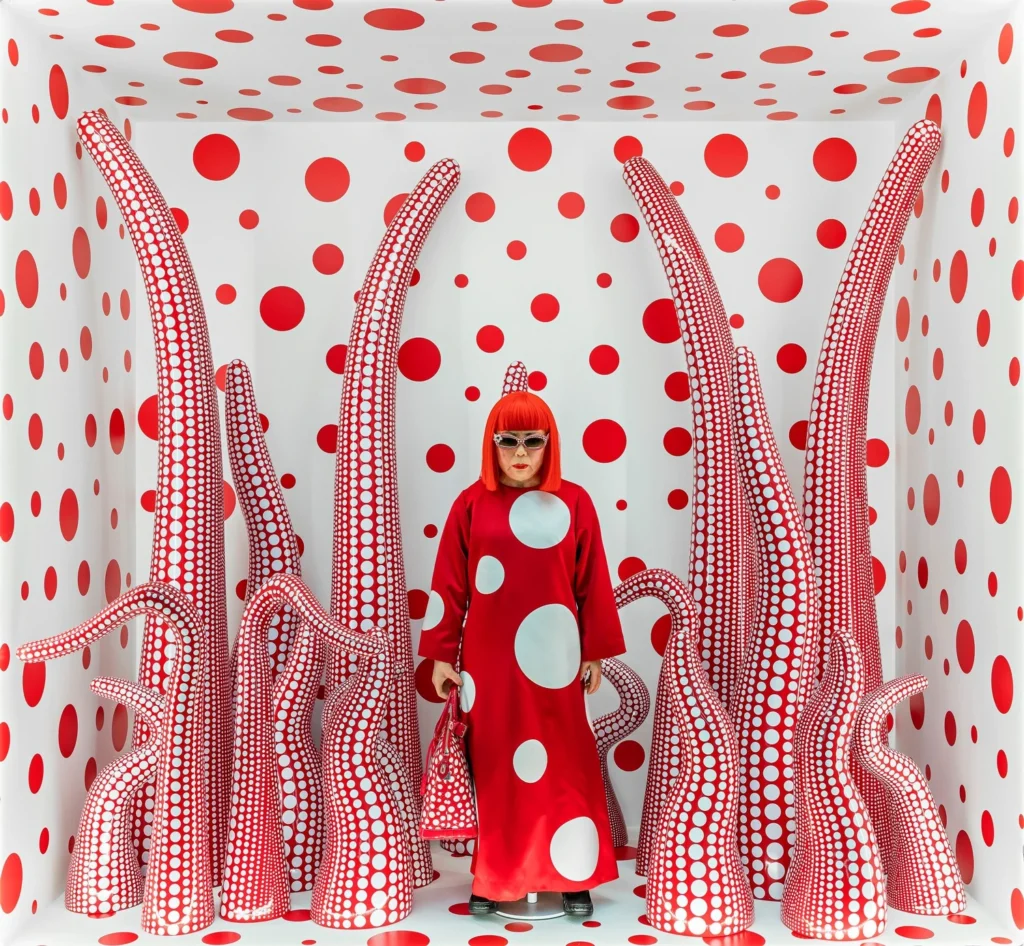
IV. The Pursuit of the Infinite: Performance Art and Installations
1. Happenings and the Body as a Canvas
Yayoi Kusama’s artistic practice is marked by her ability to transcend the traditional boundaries of visual art, incorporating elements of performance and installation into her work to create immersive experiences that engage all the senses. Her “Happenings,” a term popularized by Allan Kaprow to describe participatory performance events, were pivotal in expanding the scope of her artistic inquiry. In these performances, Kusama often used her own body as a canvas, further blurring the lines between art and life, the self and the other.
One of the most famous examples of Kusama’s performance art is her series of “Body Festivals” in the 1960s, which took place in various locations around New York City. These events were radical for their time, combining elements of performance, painting, and installation to create a space where participants could engage directly with the work. In these Happenings, Kusama and her collaborators painted each other’s bodies with polka dots, effectively transforming themselves into living artworks. The act of painting bodies—both her own and those of others—was a deeply symbolic gesture, representing the obliteration of the individual and the merging of the self with the infinite.
Kusama’s use of the body as a canvas was also a way of challenging conventional notions of art and the role of the artist. By making her own body a part of the artwork, Kusama questioned the traditional separation between the creator and the creation, the subject and the object. This merging of the self with the art was not just a visual statement but a philosophical one, reflecting her ongoing exploration of the boundaries between the self and the universe.
In addition to their visual impact, Kusama’s Happenings were also deeply political. They often took place in public spaces and were open to the participation of anyone who wished to join, effectively democratizing the artistic experience and breaking down the barriers between the artist and the audience. These performances were also a form of protest against the rigid structures of the art world and the broader societal norms that sought to constrain individual expression. Kusama’s Happenings were acts of defiance, challenging the status quo and asserting the right of the individual to define their own reality.
2. The Emergence of Infinity Rooms
Another significant development in Kusama’s career was the creation of her Infinity Rooms—immersive installations that use mirrors, lights, and reflective surfaces to create the illusion of infinite space. These installations are among her most famous works and represent the culmination of her lifelong exploration of infinity, self-obliteration, and the dissolution of boundaries.
The first of these installations, “Infinity Mirror Room—Phalli’s Field” (1965), featured a room filled with soft, stuffed phallic shapes covered in red polka dots, reflected infinitely by the mirrored walls. The viewer, upon entering the room, was confronted with an overwhelming sense of infinite space, where the boundaries between the self and the surroundings were blurred and eventually dissolved. This effect was both disorienting and mesmerizing, forcing the viewer to confront the vastness of the universe and their own place within it.
The Infinity Rooms are not just about visual spectacle; they are also deeply philosophical. They invite the viewer to step into Kusama’s world, to experience the infinite as she sees it, and to lose themselves in the process. These installations challenge the viewer’s perception of reality, creating a space where the physical and the metaphysical intersect, and where the self is both present and absent.
Kusama’s Infinity Rooms also reflect her ongoing engagement with the themes of repetition and self-obliteration. The use of mirrors and reflective surfaces creates a sense of endless repetition, as the images are reflected back and forth, creating an infinite loop. This repetition is not just a visual effect; it is a reflection of Kusama’s own psychological state, where the boundaries between the self and the universe are constantly shifting and dissolving.
The Infinity Rooms are also a testament to Kusama’s ability to create immersive environments that engage the viewer on multiple levels. These installations are not just about visual aesthetics; they are about creating a space where the viewer can experience the infinite, both physically and psychologically. The viewer is invited to lose themselves in the work, to become part of the infinite, and to experience the dissolution of the self in a way that is both profound and unsettling.
3. Immersive Environments and Psychological Impact
Kusama’s Infinity Rooms represent a significant shift in the way we think about art and the viewer’s role within it. These installations are not just objects to be observed; they are environments to be experienced, spaces where the boundaries between the self and the artwork dissolve, allowing for a more profound connection with the infinite.
The psychological impact of these environments is central to their power. Upon entering an Infinity Room, the viewer is immediately confronted with a sense of disorientation, as the mirrored surfaces create an overwhelming sense of infinite space. This disorientation is not just a visual effect; it is a reflection of Kusama’s own experiences of losing herself in the infinite, of being both present and absent, both self and other.
The Infinity Rooms also challenge the viewer’s perception of reality, forcing them to confront the vastness of the universe and their own place within it. The use of mirrors and reflective surfaces creates a sense of endless repetition, where the boundaries between the self and the surroundings are constantly shifting and dissolving. This effect is both mesmerizing and unsettling, creating a space where the viewer can experience the infinite in a way that is both physical and psychological.
Kusama’s ability to create these immersive environments is a testament to her unique vision and her deep understanding of the human psyche. The Infinity Rooms are not just about visual spectacle; they are about creating a space where the viewer can experience the infinite, both physically and psychologically. These installations invite the viewer to step into Kusama’s world, to experience the infinite as she sees it, and to lose themselves in the process.
The psychological impact of the Infinity Rooms is also a reflection of Kusama’s own struggles with mental illness. These installations are a way of externalizing her experiences, of creating a space where the viewer can experience the same sense of disorientation and dissolution that she has felt throughout her life. In this way, the Infinity Rooms are not just works of art; they are also therapeutic spaces, where Kusama can confront her own fears and anxieties, and where the viewer can engage with their own sense of self.
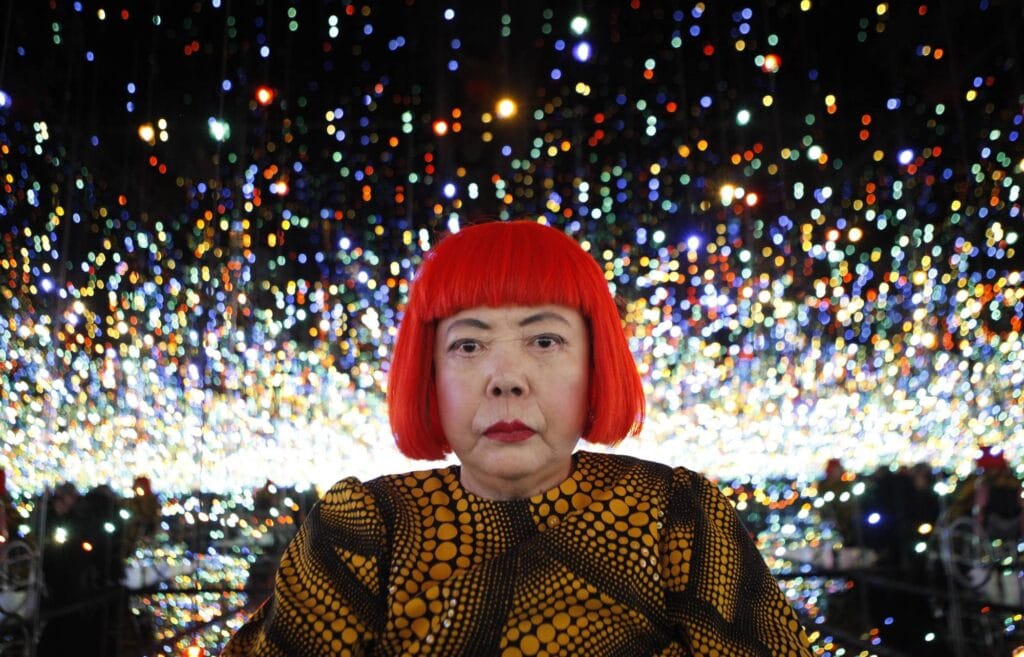
V. The Return to Japan: Reconciliation and Continuation
1. Reconnection with Japanese Culture
In the 1970s, after more than a decade of groundbreaking work in the United States, Yayoi Kusama made the momentous decision to return to Japan. This return marked a critical phase in her career and personal life, characterized by both a physical and psychological reconnection with her roots. Japan, which she had left behind in pursuit of greater artistic freedom, now became a space for reflection, healing, and continued artistic evolution.
The Japan to which Kusama returned was markedly different from the one she had left. The post-war years had brought significant cultural shifts, with the nation experiencing rapid modernization and Westernization. Despite these changes, Japan’s artistic traditions remained a potent force, and Kusama found herself reengaging with these cultural practices in new and innovative ways.
Kusama’s return to Japan was not without its challenges. Her avant-garde style, honed in the experimental art world of New York, initially clashed with the more conservative Japanese art scene. However, rather than retreating into the familiar, Kusama embraced this tension as a source of creative inspiration. She began to incorporate elements of traditional Japanese art into her work, drawing on the minimalist aesthetics of Zen Buddhism, the symbolism of nature, and the meticulous craftsmanship of Japanese artisanship.
One of the most striking aspects of Kusama’s work during this period is her re-engagement with the concept of “Mono no Aware,” a Japanese aesthetic principle that emphasizes the beauty and transience of life. This concept resonated deeply with Kusama, whose work had always been concerned with themes of infinity, self-obliteration, and the ephemeral nature of existence. By integrating this traditional Japanese sensibility into her work, Kusama was able to forge a new artistic identity that was both global and deeply rooted in her cultural heritage.
This phase of her career also saw Kusama grappling with her own identity as a Japanese woman in the international art world. Her return to Japan forced her to confront the cultural and social norms that she had sought to escape by moving to the West. However, instead of rejecting these norms, Kusama found ways to incorporate them into her work, creating a unique fusion of Eastern and Western influences that would come to define her late career.
2. Mental Health and Artistic Output
Kusama’s return to Japan was also marked by a deepening of her struggles with mental illness, which had been a constant presence in her life since childhood. In 1977, she voluntarily admitted herself to the Seiwa Hospital for the Mentally Ill in Tokyo, where she has lived and worked ever since. This decision to enter a psychiatric institution was both a personal and artistic choice, allowing her to manage her mental health while continuing to produce art.
Living in the hospital provided Kusama with a stable environment in which to create, and her proximity to her studio, located a short distance from the hospital, allowed her to maintain a rigorous work schedule. Despite the challenges posed by her mental health, Kusama’s artistic output during this period was prolific, encompassing painting, sculpture, installation, and literature. Her work became increasingly introspective, reflecting her ongoing battles with hallucinations, obsessive-compulsive thoughts, and existential fears.
Kusama’s mental health struggles are inextricably linked to her artistic practice. Throughout her life, she has used art as a means of coping with her psychological difficulties, channeling her fears, anxieties, and obsessions into her work. This process of externalization not only provided her with a sense of control over her inner turmoil but also allowed her to communicate her experiences to a broader audience.
Her work during this period is characterized by a heightened sense of fragility and impermanence. The polka dots, nets, and repetitive patterns that had long been a part of her visual language took on new meanings, representing not only infinity and self-obliteration but also the precariousness of life and the inevitability of death. Kusama’s work became a meditation on the human condition, exploring themes of mortality, suffering, and the search for meaning in a seemingly indifferent universe.
At the same time, Kusama’s decision to live and work within a psychiatric institution challenges conventional notions of the artist as a solitary genius, removed from the realities of everyday life. By choosing to remain within the hospital, Kusama rejected the myth of the artist as a heroic individual, instead embracing her vulnerability and dependence on others. This decision reflects her broader philosophy of art as a means of connection and healing, both for herself and for those who engage with her work.
3. New Forms and Expanding Media
During her later years in Japan, Kusama continued to expand the scope of her artistic practice, exploring new forms and media that allowed her to further express her complex inner world. This period saw her experimenting with large-scale sculptures, public art installations, and digital media, as well as continuing her work in painting, drawing, and literature.
One of the most significant developments during this period was Kusama’s exploration of large-scale outdoor sculptures and public art installations. These works, often featuring her signature polka dots and organic shapes, brought her vision of infinity and self-obliteration into the public realm, creating immersive environments that engaged viewers on multiple levels. Kusama’s public art installations can be found in cities around the world, from Tokyo to New York to Singapore, each one offering a space for reflection, connection, and contemplation.
Kusama also began to experiment with new materials and technologies, incorporating elements of digital media into her work. Her “Obliteration Room,” for example, invites visitors to place stickers on the surfaces of a completely white room, gradually transforming the space into a riot of color and pattern. This interactive installation reflects Kusama’s ongoing interest in the dissolution of boundaries, as the viewers themselves become active participants in the creation of the artwork.
In addition to her visual art, Kusama also continued to write, producing novels, poetry, and autobiographical works that provide insight into her life and artistic philosophy. Her writing, like her visual art, is characterized by its exploration of themes of infinity, self-obliteration, and the search for meaning in a chaotic world. Through her literary work, Kusama offers a window into her psyche, revealing the profound connections between her art and her experiences of mental illness.
Kusama’s ability to continually reinvent herself and her work is a testament to her resilience and creativity. Even as she confronted the challenges of aging and mental illness, Kusama remained committed to her artistic practice, constantly pushing the boundaries of what art can be and what it can express. Her late-period works are a reflection of her lifelong quest to understand and articulate the complexities of the human experience, offering a powerful testament to the enduring power of art.
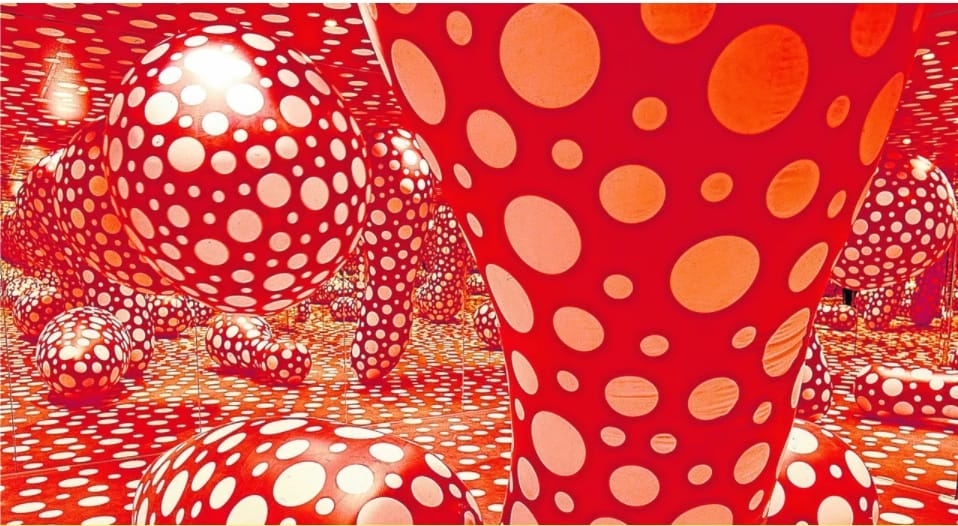

VI. Late Period Works: Global Acclaim and Artistic Legacy
1. Global Exhibitions and Recognition
As Yayoi Kusama entered the later stages of her career, her work gained unprecedented global recognition, with major exhibitions, retrospectives, and installations being staged in leading museums and galleries worldwide. The international art community’s renewed interest in Kusama’s work can be seen as both a recognition of her immense contributions to contemporary art and a testament to the timeless and universal appeal of her artistic vision.
One of the key milestones in Kusama’s late career was her participation in the 1993 Venice Biennale, where she represented Japan with a solo exhibition. This marked the first time a female artist had represented Japan at the Biennale, a significant achievement that highlighted Kusama’s status as one of the most important artists of her generation. The exhibition featured her iconic polka dots, large-scale installations, and a series of new works that showcased her continued innovation and creativity.
Following her success at the Venice Biennale, Kusama’s work was featured in a series of major retrospectives, including exhibitions at the Museum of Modern Art in New York, the Tate Modern in London, and the Centre Pompidou in Paris. These retrospectives provided a comprehensive overview of Kusama’s career, tracing the evolution of her work from her early years in Japan to her time in New York and her later years in Tokyo. The exhibitions were met with critical acclaim, with many reviewers highlighting the depth and complexity of Kusama’s work, as well as its relevance to contemporary issues such as mental health, identity, and the environment.
Kusama’s work also found a new audience through her immersive installations, which became a global phenomenon. Her Infinity Rooms, in particular, became a must-see attraction, drawing millions of visitors to museums and galleries around the world. These installations, with their mesmerizing use of mirrors, lights, and polka dots, captured the imagination of a new generation of art lovers, many of whom were introduced to Kusama’s work through social media. The viral popularity of these installations helped to cement Kusama’s status as a cultural icon, bridging the gap between high art and popular culture.
In addition to her exhibitions and installations, Kusama received numerous awards and honors in recognition of her contributions to the arts. These include Japan’s prestigious Praemium Imperiale award for painting, the Order of Culture, and the Asahi Prize. Kusama was also named one of Time magazine’s 100 most influential people, a testament to her impact not only in the art world but also on global culture as a whole.
2. The Evolution of Themes in Later Works
In her later works, Kusama continued to explore the themes that had defined her career, while also introducing new elements that reflected her ongoing engagement with contemporary issues and her own personal journey. These works are characterized by a sense of introspection and reflection, as Kusama looked back on her life and career, while also continuing to push the boundaries of her artistic practice.
One of the key themes in Kusama’s late work is the concept of mortality and the passage of time. As she aged, Kusama became increasingly aware of her own mortality, and this awareness is reflected in her work. Her later paintings, for example, often feature images of skulls, bones, and other symbols of death, rendered in her signature style of bold colors and repetitive patterns. These works are not morbid, however; rather, they are a celebration of life’s transience, a reminder of the beauty and fragility of existence.
At the same time, Kusama’s later works also reflect her continued interest in the infinite and the cosmic. Her Infinity Nets, for example, took on new forms, with the nets becoming more complex and intricate, their patterns expanding and contracting in ways that suggest the endless cycles of creation and destruction that define the universe. These works are both a continuation of Kusama’s earlier explorations of infinity and a reflection of her deepening understanding of the interconnectedness of all things.
Kusama’s later works also reflect her engagement with contemporary social and political issues. Her installation “Pumpkin,” for example, is both a playful and poignant commentary on consumer culture, with its oversized, brightly colored pumpkins serving as a symbol of abundance and excess. At the same time, the work also reflects Kusama’s personal connection to the pumpkin, a motif that has appeared in her work since childhood and which she has described as a source of comfort and inspiration.
In addition to these thematic explorations, Kusama’s late works are also notable for their formal innovations. She continued to experiment with new materials and techniques, incorporating elements of digital media, sculpture, and performance into her work. Her “Infinity Mirrored Rooms” series, for example, pushed the boundaries of immersive art, creating spaces that are both physically and psychologically engaging. These works challenge the viewer’s perception of reality, creating a sense of disorientation and wonder that is both exhilarating and unsettling.
Overall, Kusama’s late works represent a culmination of her lifelong artistic journey, bringing together the themes and ideas that have defined her career while also introducing new elements that reflect her ongoing engagement with the world around her. These works are a testament to Kusama’s ability to continually reinvent herself and her art, even as she confronts the challenges of aging and mortality.
3. Influence on Contemporary Art and Popular Culture
Yayoi Kusama’s influence on contemporary art and popular culture cannot be overstated. Her work has inspired countless artists, designers, and creatives across a wide range of disciplines, from visual art to fashion to music. Her unique blend of avant-garde aesthetics, personal narrative, and universal themes has resonated with audiences around the world, making her one of the most influential artists of the 20th and 21st centuries.
One of the key aspects of Kusama’s influence is her ability to bridge the gap between high art and popular culture. Her work, with its bold colors, repetitive patterns, and immersive installations, has a universal appeal that transcends traditional boundaries. This accessibility has made Kusama a cultural icon, her work appearing in everything from fashion collaborations to music videos to social media trends.
In the world of visual art, Kusama’s influence can be seen in the work of contemporary artists who explore similar themes of infinity, self-obliteration, and the dissolution of boundaries. Her use of repetitive patterns and immersive environments has inspired a new generation of artists who are interested in creating works that engage the viewer on multiple levels. Kusama’s work has also had a significant impact on the development of installation art, with her Infinity Rooms serving as a blueprint for artists interested in creating immersive, experiential environments.
Kusama’s influence extends beyond the visual arts to the worlds of fashion and design. Her collaborations with major fashion brands, such as Louis Vuitton, have brought her work to a global audience, while also challenging traditional notions of what constitutes high art. These collaborations have not only introduced Kusama’s work to a new generation of art lovers but have also helped to redefine the relationship between art and commerce.
In addition to her influence on contemporary art and fashion, Kusama has also made a significant impact on popular culture. Her work has been featured in music videos, films, and television shows, and her iconic polka dots have become a symbol of creativity and individuality. Kusama’s ability to connect with audiences across a wide range of mediums is a testament to the power of her vision and the universality of her themes.
Kusama’s influence on contemporary art and popular culture is also reflected in the way her work has been embraced by the public. Her Infinity Rooms, in particular, have become a cultural phenomenon, attracting millions of visitors to museums and galleries around the world. The viral popularity of these installations, driven in part by social media, has helped to elevate Kusama’s work to new heights, making her one of the most celebrated and recognizable artists of her time.
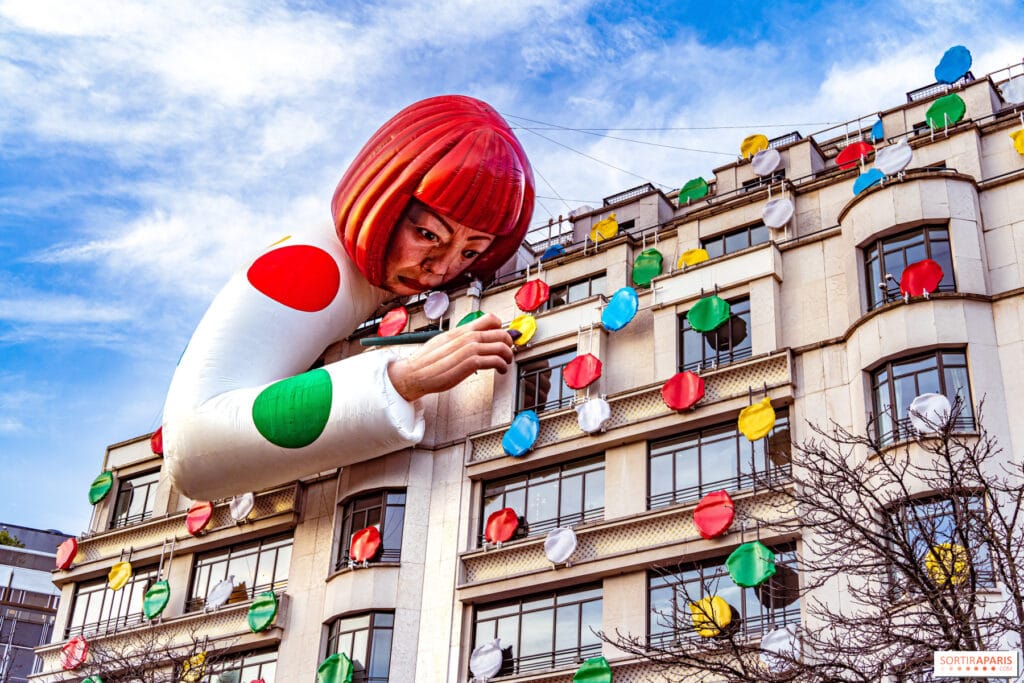
VII. The Philosophical Underpinnings of Kusama’s Art
1. Infinity and the Dissolution of the Self
At the core of Yayoi Kusama’s art is a profound exploration of the concept of infinity and its implications for the self. This theme is central to much of her work, from her early paintings and drawings to her later installations and sculptures. Kusama’s interest in infinity is not merely a visual or aesthetic concern; it is also deeply philosophical, reflecting her ongoing quest to understand the nature of existence and the self’s place within the universe.
For Kusama, infinity represents both a source of wonder and a source of terror. On one hand, the idea of infinity suggests boundless possibilities, a universe without limits where anything is possible. On the other hand, infinity also represents the dissolution of the self, the loss of individual identity in the face of the vastness of the cosmos. This duality is central to Kusama’s work, which often oscillates between celebration and anxiety, creation and destruction, presence and absence.
Kusama’s fascination with infinity is reflected in her use of repetitive patterns, particularly polka dots and nets, which create a sense of endless expansion. These patterns, which often cover entire canvases or fill entire rooms, suggest a universe that is constantly growing and evolving, with no clear beginning or end. At the same time, the repetitive nature of these patterns also suggests a kind of self-obliteration, as the individual elements are absorbed into the larger whole, losing their distinct identity in the process.
This tension between infinity and self-obliteration is also evident in Kusama’s Infinity Rooms, which create an immersive environment where the boundaries between the self and the surroundings are blurred and eventually dissolved. In these installations, the viewer is confronted with an overwhelming sense of infinite space, where the self seems to disappear into the vastness of the universe. This experience can be both exhilarating and disorienting, as the viewer is forced to confront the fragility of their own existence and the insignificance of the self in the face of the infinite.
Kusama’s exploration of infinity and the dissolution of the self is not just a philosophical exercise; it is also deeply personal. Throughout her life, Kusama has struggled with mental illness, including hallucinations, obsessive-compulsive thoughts, and a persistent fear of annihilation. Her art can be seen as a way of grappling with these fears, of making sense of the chaos and uncertainty that has defined her existence. By confronting the infinite, Kusama is able to find a sense of peace and acceptance, even in the face of the unknown.
At the same time, Kusama’s exploration of infinity also reflects her belief in the interconnectedness of all things. For Kusama, the dissolution of the self is not just a loss; it is also a return to the larger whole, a recognition of the self’s place within the cosmic web. This idea of interconnectedness is central to Kusama’s philosophy, as it suggests a universe where all things are connected, where the boundaries between the self and the other are fluid and permeable.
In this way, Kusama’s art can be seen as both a meditation on the nature of existence and a means of finding connection and meaning in a seemingly indifferent universe. Her exploration of infinity and the dissolution of the self is a reflection of her own journey, a journey that has taken her from the depths of despair to the heights of artistic achievement.
2. The Role of Repetition and Obsession in Art
Repetition is a fundamental element of Yayoi Kusama’s art, one that is deeply intertwined with her psychological experiences and philosophical beliefs. Throughout her career, Kusama has employed repetition as both a visual strategy and a conceptual framework, using it to explore themes of infinity, self-obliteration, and the dissolution of boundaries. This use of repetition is not merely a formal choice; it is also a reflection of Kusama’s obsessive-compulsive tendencies, which have played a central role in her artistic practice.
Kusama’s obsession with repetition can be traced back to her childhood, when she began experiencing vivid hallucinations of patterns and shapes that seemed to engulf her surroundings. These hallucinations were often accompanied by a sense of overwhelming fear and anxiety, as the boundaries between the self and the environment became blurred and indistinct. In an attempt to cope with these experiences, Kusama began to recreate the patterns she saw in her mind, using repetition as a way of imposing order on the chaos of her thoughts.
This use of repetition as a coping mechanism became a defining feature of Kusama’s art, particularly in her early work, where she would cover entire canvases with repetitive patterns of dots, nets, and other motifs. These patterns, while visually striking, also serve a deeper purpose: they are a means of externalizing her inner experiences, of making visible the invisible forces that have shaped her life. By repeating these patterns over and over again, Kusama is able to take control of her fears, transforming them into something tangible and manageable.
Repetition in Kusama’s work is also closely linked to the concept of infinity. The endless repetition of patterns creates a sense of infinite expansion, where the boundaries between the self and the environment are dissolved, and the viewer is invited to lose themselves in the work. This experience of infinity is central to Kusama’s philosophy, as it reflects her belief in the interconnectedness of all things and the dissolution of individual identity in the face of the cosmos.
At the same time, repetition in Kusama’s work can also be seen as a form of self-obliteration, a way of erasing the self through the relentless repetition of patterns and motifs. This idea of self-obliteration is particularly evident in her performance art, where she would cover herself and her surroundings with polka dots, effectively erasing the boundaries between herself and the environment. This act of self-obliteration is both a personal and philosophical statement, reflecting Kusama’s desire to escape the confines of the self and merge with the infinite.
Kusama’s use of repetition also challenges traditional notions of artistic originality and creativity. In a culture that often values novelty and innovation, Kusama’s repetitive patterns can be seen as a radical rejection of these values, a statement that challenges the very foundations of artistic production. By embracing repetition, Kusama is able to create works that are both unique and universal, personal and collective.
Furthermore, Kusama’s repetition can also be seen as a form of ritual, a way of engaging with the world that is both meditative and transformative. The repetitive nature of her work invites the viewer to enter into a state of contemplation, where the boundaries between the self and the work dissolve, and a deeper connection with the universe is established. This ritualistic aspect of Kusama’s work is closely related to her interest in Eastern philosophy, particularly Zen Buddhism, which emphasizes the importance of repetition and ritual in the pursuit of enlightenment.
In this sense, Kusama’s art can be seen as both a personal and spiritual practice, one that is deeply connected to her experiences of mental illness and her quest for meaning in a chaotic world. Through repetition, Kusama is able to transcend the limitations of the self, creating works that resonate with the viewer on both a visual and emotional level.
3. Art as Therapy: The Healing Power of Kusama’s Work
For Yayoi Kusama, art has always been more than just a means of self-expression; it has also been a vital tool for survival, a way of coping with the mental health challenges that have shaped her life. Throughout her career, Kusama has used art as a form of therapy, channeling her fears, anxieties, and obsessions into her work. This therapeutic aspect of Kusama’s art is not just a personal endeavor; it is also a testament to the healing power of creativity, both for the artist and for those who engage with her work.
Kusama’s experiences with mental illness began at an early age, and her struggles with hallucinations, obsessive-compulsive thoughts, and anxiety have been a constant presence in her life. These experiences have profoundly influenced her art, which often reflects her attempts to make sense of the chaos and uncertainty that has defined her existence. In this sense, Kusama’s art can be seen as a form of self-therapy, a way of externalizing her inner turmoil and gaining control over her fears.
One of the key ways in which Kusama uses art as therapy is through the process of repetition. As previously discussed, repetition plays a central role in Kusama’s work, serving as a means of imposing order on the chaos of her thoughts. By repeating patterns and motifs over and over again, Kusama is able to create a sense of stability and predictability, which helps to alleviate her anxiety. This process of repetition is not just a visual strategy; it is also a therapeutic practice, one that allows Kusama to confront and manage her fears in a controlled and safe environment.
Kusama’s use of art as therapy is also evident in her immersive installations, particularly her Infinity Rooms, which create a space where the viewer can experience the same sense of disorientation and dissolution that Kusama herself has felt throughout her life. These installations are not just works of art; they are also therapeutic environments, where the boundaries between the self and the surroundings are blurred, and the viewer is invited to lose themselves in the experience. In this way, Kusama’s Infinity Rooms offer a form of therapy not only for the artist but also for the viewer, who is able to engage with their own sense of self in a new and profound way.
In addition to her visual art, Kusama has also used writing as a form of therapy, producing novels, poetry, and autobiographical works that provide insight into her experiences of mental illness. Her writing, like her visual art, is deeply personal, reflecting her ongoing struggles with hallucinations, anxiety, and the search for meaning in a chaotic world. Through her writing, Kusama is able to articulate the complex emotions and experiences that have shaped her life, offering a sense of catharsis and healing.
Kusama’s use of art as therapy is not just a personal endeavor; it is also a reflection of her broader philosophy of art as a means of connection and healing. Throughout her career, Kusama has been committed to creating works that resonate with the viewer on an emotional level, offering a space for reflection, contemplation, and healing. This commitment to the therapeutic power of art is evident in her public art installations, which invite the viewer to engage with their own sense of self and the world around them.
In this sense, Kusama’s art can be seen as both a personal and collective form of therapy, one that offers a means of coping with the challenges of life in a chaotic and uncertain world. Her work is a testament to the power of creativity to heal, transform, and connect, both for the artist and for those who engage with her work.
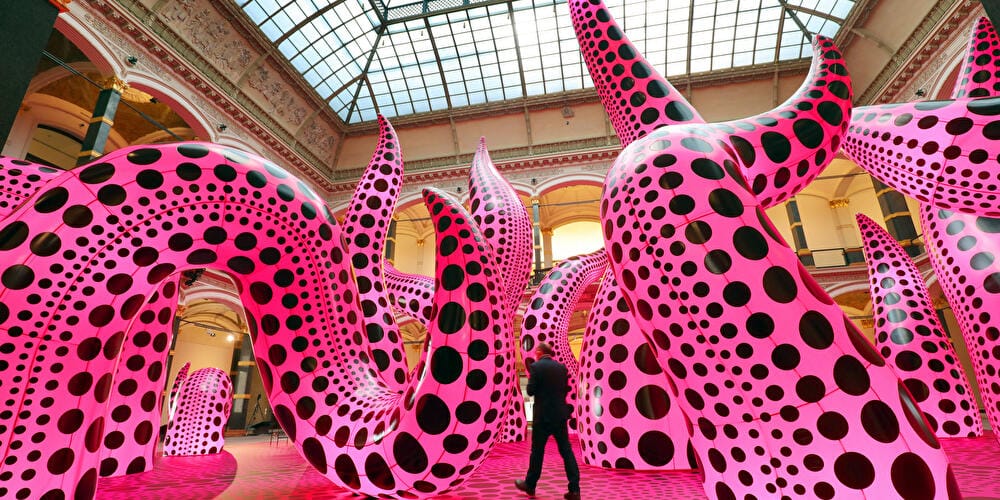
VIII. The Cultural and Global Impact of Yayoi Kusama’s Art
1. Kusama as a Global Cultural Icon
Yayoi Kusama has transcended the traditional confines of the art world to become a global cultural icon. Her distinctive visual language, characterized by polka dots, net patterns, and mirrored environments, has permeated various aspects of popular culture, from fashion and design to music and film. Kusama’s influence extends far beyond the boundaries of the gallery or museum; she has become a symbol of creativity, resilience, and the transformative power of art in the global imagination.
Kusama’s status as a cultural icon is reflected in the widespread recognition and celebration of her work across the globe. Major retrospectives of her work have been held in prestigious institutions such as the Tate Modern in London, the Museum of Modern Art in New York, and the National Art Center in Tokyo. These exhibitions have not only solidified Kusama’s position as one of the most important artists of her time but have also introduced her work to new audiences, further expanding her influence.
Kusama’s popularity is also evident in the way her work has been embraced by the public. Her immersive installations, particularly the Infinity Rooms, have become a cultural phenomenon, attracting millions of visitors and generating extensive coverage on social media. These installations, with their mesmerizing play of light, color, and reflection, have become a must-see experience for art lovers and casual viewers alike, creating a sense of communal engagement and shared wonder.
In addition to her visual art, Kusama’s collaborations with major fashion brands, such as Louis Vuitton, have brought her work into the mainstream, making her distinctive patterns and motifs a part of global fashion culture. These collaborations have not only introduced Kusama’s work to a broader audience but have also challenged traditional notions of what constitutes high art, blurring the lines between art, fashion, and commerce.
Kusama’s influence as a cultural icon is also evident in the way her life and work have been represented in various forms of media. Documentaries, biopics, and books about her life have provided insight into her artistic process and personal struggles, while also contributing to the mythos surrounding her persona. Kusama has become a symbol of the artist as a visionary, someone who, despite immense personal challenges, has remained committed to her creative vision and has succeeded in making a lasting impact on the world.
2. The Intersection of Art and Commerce: Kusama’s Collaborations
One of the most remarkable aspects of Yayoi Kusama’s career is her ability to navigate the intersection of art and commerce without compromising her artistic integrity. Kusama’s collaborations with major fashion brands and commercial entities have not only expanded her audience but have also redefined the relationship between art and commerce, challenging the traditional boundaries that have long separated these realms.
Kusama’s collaboration with Louis Vuitton in 2012 is perhaps the most notable example of her success in bridging the gap between art and fashion. The collection, which featured Kusama’s signature polka dots on a range of products, from clothing and accessories to store displays, was a global success. The collaboration was not just a commercial venture; it was also a reflection of Kusama’s long-standing interest in fashion and design, which dates back to her early years in New York, where she designed and produced avant-garde clothing that blurred the lines between art and fashion.
This collaboration with Louis Vuitton was significant not only for its commercial success but also for the way it introduced Kusama’s work to a new audience, many of whom may not have been familiar with her art before. By bringing her distinctive patterns and motifs into the world of high fashion, Kusama was able to reach a broader demographic, including younger audiences who were drawn to the bold, playful aesthetic of her designs.
Kusama’s ability to successfully navigate the commercial art world is also evident in her numerous other collaborations, including partnerships with major brands such as Veuve Clicquot and Uniqlo. These collaborations, while commercial in nature, have been carefully curated to align with Kusama’s artistic vision and values. In each case, Kusama has been able to maintain control over the creative process, ensuring that her work remains true to her vision, even as it enters the commercial marketplace.
The success of Kusama’s collaborations has also had a broader impact on the art world, challenging traditional notions of artistic purity and originality. Kusama’s willingness to engage with the commercial world, to bring her art into new and unexpected contexts, has helped to redefine the boundaries of contemporary art, opening up new possibilities for artists who are interested in exploring the intersection of art and commerce.
Moreover, Kusama’s collaborations have also raised important questions about the nature of art in the modern world. In an age where the lines between art, fashion, and commerce are increasingly blurred, Kusama’s work challenges us to reconsider what it means to be an artist in the 21st century. Her success in navigating these complex and often contradictory realms is a testament to her creativity, resilience, and vision.
3. Kusama’s Influence on Emerging Artists and Artistic Movements
Yayoi Kusama’s impact on contemporary art is not limited to her own work; she has also had a profound influence on a new generation of artists who have been inspired by her unique vision, innovative techniques, and fearless exploration of complex themes. Kusama’s influence can be seen in the work of emerging artists across a wide range of mediums, from painting and sculpture to installation and performance art.
One of the most significant aspects of Kusama’s influence is her role in pioneering immersive art and experiential installations. Kusama’s Infinity Rooms, with their mesmerizing interplay of light, mirrors, and space, have become a blueprint for contemporary artists who are interested in creating immersive environments that engage the viewer on multiple levels. Artists such as Olafur Eliasson, James Turrell, and teamLab have all drawn inspiration from Kusama’s work, creating large-scale installations that challenge the viewer’s perception of space, light, and reality.
Kusama’s influence is also evident in the work of artists who explore themes of repetition, obsession, and the dissolution of boundaries. Her use of repetitive patterns and motifs, which create a sense of infinite expansion and self-obliteration, has inspired a new generation of artists who are interested in exploring similar themes in their work. This influence can be seen in the work of artists such as Yayoi Kusama herself, who continues to push the boundaries of her practice, as well as in the work of younger artists who are drawn to the psychological and philosophical depth of her work.
In addition to her influence on visual art, Kusama’s work has also had an impact on other artistic disciplines, including fashion, design, and music. Her collaborations with fashion brands and designers have not only introduced her work to new audiences but have also inspired a new wave of creativity in the fashion world, where designers are increasingly drawing on the bold colors, patterns, and motifs that define Kusama’s work. Similarly, musicians and performers have also been influenced by Kusama’s work, incorporating her distinctive visual language into their stage designs, music videos, and performances.
Kusama’s influence on contemporary art is not just a matter of style or technique; it is also a reflection of her broader philosophy of art as a means of connection, healing, and transformation. Kusama’s work challenges us to think differently about the nature of art, to question the boundaries between the self and the world, and to find meaning in the infinite complexities of existence. This philosophy has resonated with a new generation of artists who are interested in using their work to explore similar themes of identity, connection, and transcendence.
In this way, Kusama’s influence extends far beyond her own work, shaping the direction of contemporary art and inspiring a new generation of artists who are carrying forward her legacy. Her impact on the art world is a testament to the enduring power of her vision, and to the ways in which her work continues to inspire, challenge, and transform those who engage with it.

Conclusion: The Ever-Expanding Legacy of Yayoi Kusama
Yayoi Kusama’s art represents a convergence of personal struggle and universal themes, manifesting a unique legacy that continues to resonate deeply across various dimensions of culture and creativity. Her journey from a small town in Japan to becoming a global cultural icon underscores the profound impact of her work on the art world and beyond.
Kusama’s artistry—characterized by its vibrant polka dots, intricate patterns, and immersive environments—has transformed her personal experiences of mental illness into a powerful, transcendent visual language. Her exploration of infinity, repetition, and self-obliteration speaks to a broader philosophical inquiry into existence, identity, and the cosmos. By navigating these themes with both courage and innovation, Kusama has redefined the possibilities of contemporary art, creating works that engage viewers on both intellectual and emotional levels.
Her influence extends well beyond the confines of traditional art spaces. Kusama has successfully bridged the gap between high art and popular culture, making her work accessible to a diverse global audience. Her collaborations with major fashion brands and her widespread media presence have solidified her status as a cultural icon, illustrating the fluidity between art and commerce and challenging conventional boundaries within both realms.
The global reception of Kusama’s work, particularly her immersive installations like the Infinity Rooms, underscores the universality of her artistic vision. These installations offer an experiential engagement that dissolves the boundaries between the self and the art, allowing viewers to experience a sense of infinite space and connection. This immersive quality has made Kusama’s work not just a visual experience but a profound, participatory event that invites introspection and wonder.
Kusama’s influence on emerging artists and artistic movements is a testament to her enduring legacy. Her innovative approaches to repetition, pattern, and immersive environments continue to inspire a new generation of creators who explore similar themes in their own work. This ripple effect underscores the lasting impact of Kusama’s vision, as her contributions to the art world encourage ongoing exploration and innovation.
In reflecting on Kusama’s legacy, it is clear that her work offers more than just aesthetic pleasure; it provides a space for personal and collective reflection. Her art acts as a mirror to the infinite complexities of existence, challenging us to confront our fears, embrace our interconnectedness, and find meaning in a seemingly chaotic world.
As we move forward, Yayoi Kusama’s art will undoubtedly continue to inspire and captivate audiences around the world. Her fearless exploration of personal and universal themes, combined with her ability to bridge diverse cultural and commercial spaces, ensures that her legacy will endure. Kusama’s work is a powerful reminder of the transformative potential of art, affirming its capacity to heal, connect, and illuminate the human experience.
